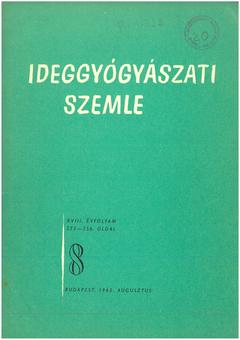The eLitMed.hu medical portal uses computer cookies for convenient operation. Detailed information can be found in the Cookie-policy.
Clinical Neuroscience - 1965;18(08)
Content
[Diagnostic and aetiological problems in bridge lesions]
[The importance and frequency of bridge lesions have been known since Kubik and Adams (1946).In my presentation I will focus on vascular and tumoral bridge lesions. I will only briefly refer to the other aetiological factors. Of my eight clinicopathological cases, 5 are anaemic or haemorrhagic infarcts, 3 are tumours; of these, 2 are intrapontine and 1 extrapontine. Of the 5 infarctus cases, symptoms developed acutely in 3 patients and subcutaneously in 2. ]
[Bruxism and chronic headache]
[1. After describing the symptomatology and literature of bruxism (teeth grinding, empty grinding), the author investigated its relationship with chronic headache based on his own experience with patients. 2. "Bruxism cephalea" is a myogenic pain localized to the masticatory muscles, which aetiopathogenetically can be divided into psychogenic and orthodontogenic groups. 3. 19 out of 21 cases were dominated by psychogenitas, in which psychotherapeutic, sedative, general and local relaxation treatment resulted in the resolution of the typical complaints. In two cases orthodontic, stomatological sanatio resolved the irritative situation, secondary masticatory spasm. 4. In cases of chronic head and facial pain that defy any treatment, the possibility of bruxism, its pathogenetic role and the involvement of the stomatognathic system should be considered. ]
[Data for the topochemistry of the Bielschowsky-type family of blind idiocy]
[In two brothers with late infantile typus amaurotic idiopathy, regional differences in the amount and composition of complex lipoid material stored in neurons were detected. For example : the lam. granularisa of the cerebellar cortex is almost intact, Purkinje elements represent the only cell type stored in its dendrites, the nucl. The thematic differences in the qualitative composition of the stored material are illustrated by a comparison of Purkinje and spinal cord motor neurons ; in the dendrites of Purkinje elements an alcohol-soluble glycolipid is stored, in the cell body the same material is found bound to protein and traces of sphingomyelin. In the motile cells of the spinal cord, the free glycolipid is minimal ; in these, mainly protein-bound glycolipid and sphingo myelin are stored. The regional behaviour of storage is identical in the two siblings, but there are important differences from most of the cases reported in the literature. These features suggest that, in addition to the common pathological moments that define the disease type, there are also variable topochemical endowments that appear to be familially determined. ]
[Hypnotic suggestibility and delusions of suggestibility in schizophrenic patients]
[1. suggestibility, the most typical hypnotic symptom, is also a feature of schizophrenia (as a chronic hypnotic state) 2. In hypnosis, the influence of real stimuli is established by psychological substitution 3. Substitution is characterized by a lower degree of unconsciousness of temporary relationships. It has associative, evocative, or visceral significance. 4. Substitution is the basis of suggestibility. 5. Hypotonicity of consciousness leads to regression of associations to the degree of substitution, the activity becomes automatic and creates a sense of being uninfluenced. 6. The patient's resistance to suggestion under conditions of increasing negativism becomes automatic resistance, and in negativism, it manifests itself in delusions of suggestion through personification ideas. 7. In schizophrenic patients, the suggestibility mechanism takes place at a lower level and is related to the pathophysiological essence of the disease, the chronic hypnotic state. ]
[Reports]
[1. Report on the XXVIII Italian Psychiatric Congress 2. Lindauer Psychotherapiewoche. 3-8 May 1965]
1.
Clinical Neuroscience
[Headache registry in Szeged: Experiences regarding to migraine patients]2.
Clinical Neuroscience
[The new target population of stroke awareness campaign: Kindergarten students ]3.
Clinical Neuroscience
Is there any difference in mortality rates of atrial fibrillation detected before or after ischemic stroke?4.
Clinical Neuroscience
Factors influencing the level of stigma in Parkinson’s disease in western Turkey5.
Clinical Neuroscience
[The effects of demographic and clinical factors on the severity of poststroke aphasia]1.
2.
Clinical Oncology
[Pancreatic cancer: ESMO Clinical Practice Guideline for diagnosis, treatment and follow-up]3.
Clinical Oncology
[Pharmacovigilance landscape – Lessons from the past and opportunities for future]4.
5.



